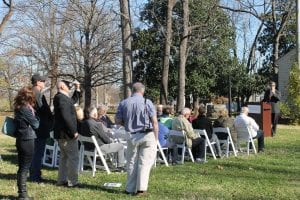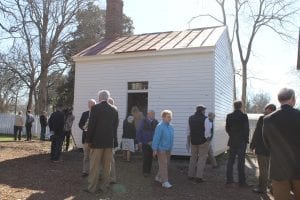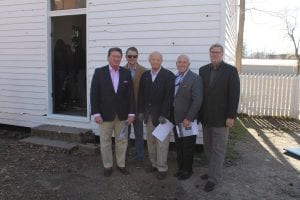RESTORED CARTER HOUSE FARM OFFICE NOW OPEN
Farm office restored to highlight battle scars from Nov. 30, 1864
FRANKLIN, TN – On Tuesday, Nov. 28 The Battle of Franklin Trust opened the Carter House farm office after the completion of a $170,000 restoration project.
Battle of Franklin Trust CEO Eric A. Jacobson and Executive Director and State Historic Preservation Officer Patrick McIntyre spoke on the significance of this preservation project. Guests were then able to tour the farm office for themselves.
“This will be the first time that the Carter farm office will be open as a historic structure,” said Eric A. Jacobson, CEO of The Battle of Franklin Trust. “We know that when visitors see the damage that hundreds of bullets made to the office, especially from the inside of the building, they will better understand the intensity of the Battle of Franklin.”
Built in the 1840s, this building was heavily damaged during the battle which was fought on Nov. 30, 1864. It was once used as an office and living space for the Carter family, and now the restored building will be a centerpiece of the tour experience at the Carter House.
The north and south interior walls of the building will remain exposed, showing the intense damage that occurred during the Battle of Franklin. It is believed to be the most battle- damaged structure still standing from the time of the American Civil War.
The restoration of the Carter House farm office was made possible through a partnership among The Battle of Franklin Trust, the Tennessee Historical Commission, Centric Architecture and Rock City Construction.
For more information about The Battle of Franklin Trust, visit https://boft.org/.
About The Battle of Franklin Trust
The Battle of Franklin Trust is a 501(c)3 management corporation acting on behalf of Franklin’s battlefield sites to contribute to a greater understanding and enrich the visitor experience of the November 30, 1864 battle. It is organized for the charitable and educational purposes of preserving, restoring, maintaining and interpreting the properties, artifacts and documents related to the battle so as to preserve an important part of the nation’s history.







